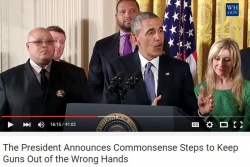Jan
7
2016

Written by Jesse McGleughlin
President Obama recently announced new executive action on gun control. According to a White House fact sheet published on Monday, the executive orders would expand background checks, increase mental health services and reporting, and shape the future of gun technology. Obama’s call for an executive order comes on the heels of his attempts, amidst refusal from Republican lawmakers, to implement stronger gun regulations following the mass shooting in Newtown, Connecticut in 2012. And while his executive action is a significant win for all those in favor of ending gun violence, it is not clear how much this will impact gun violence given significant legal barriers and the power of the National Rifle Association and its supporters.
Obama’s executive action on gun control poses an interesting set of questions; in what moments do Presidents implement executive orders? And how can we trace a relationship between grassroots movement building and the implementation of such an exertion of executive power?
On November 19, 2014, President Obama announced a different executive action, this time on immigration policy. The executive action had two major components; it offered legal reprieve to undocumented parents of U.S. citizens and permanent residents who had been in the United States for at least five years, and it expanded the Deferred Action for Childhood Arrivals (DACA) program, allowing immigrants under the age of 30 who arrived as children to apply for a deportation deferral.
In writing about the Immigrant Rights Movement, Walter Nichols argued that it was grassroots activists and marginalized immigrant activist organizations including DREAMers and day laborers that successfully pushed immigration reform. He notes that the unsuccessful attempts to implement comprehensive immigration reform led activist groups to pressure the Obama administration to use executive authority to protect undocumented immigrants. Nichols argues that these advocates understood that Congress was only one branch with power, and if Congress would not budge, there were other “pressure points;” defined as “strategic nodes or political arenas that could be used to send disruptive tremors throughout the system,” including in state and local governments, executive branches, and courts.
So the question arises: was the trajectory to the issuance of an executive action on immigration different from the trajectory regarding gun control? In the case of immigration, President Obama enacted executive action in response to pressure from grassroots activists. In the case of gun control, President Obama was not, in the same way, responding to a grassroots social movement. It would appear that he took this executive action to respond to widespread public support for background checks and other gun controls.
But regardless of the President’s motivations, we must turn back to movement building and grassroots organizing as critical social movement tools for pushing and sustaining policy change. Indeed, the administration’s current action on immigration may provide a cautionary tale about the prospects of gun control through executive action. The executive action on immigration has been delayed by lawsuits and the government is ramping up deportation of many immigrant women and children who recently came to the country. We must again think about the “pressure points,” and “strategic nodes” that we might push. And we must turn to movements like Black Lives Matter, that remind us that gun control alone will not protect the lives of Black and Brown people on the streets. It is these movements, happening in public spaces every day, that create an environment in which change is demanded, regardless of whether the government is willing to move.
